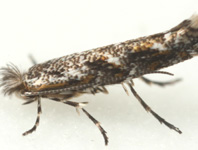Abstract
One new species of Parasphaerolaimus is described from a Brazilian estuarine system with intra-uterine development of its offspring. Parasphaerolaimus magdolnae sp. n. is distinguished from other species of the genus by the presence of only one anterior testis, spicules morphology and size and a gubernaculum without dorsal apophysis. The cuticle of the new species is striated and the position of the vulva is far posterior on the body, almost reaching the anus. The taxonomy of Parasphaerolaimus was also re-examined and two other species were transferred from Sphaerolaimus to Parasphaerolaimus after the last revision: P. pentasetus (Pastor de Ward, 1984) comb. n. and P. striatus (Allgén, 1935) comb. n. An updated identification key for all valid species of Parasphaerolaimus is included.
References
Allgén, C. (1935) Die Freilebenden Nematoden Des Öresunds. Capita Zoologica, 4 (3), 132–134.
Bastian, H.C. (1865) Monograph of the Anguillulidae, or free nematoids, marine, land, and freshwater; with decriptions of 100 new species. The Transactions of the Linnean Society of London, 25, 73–184.
https://doi.org/10.1111/j.1096-3642.1865.tb00179.xCarvalho, P.V.V.C., Santos, P.J.P. & Botter-Carvalho, M.L. (2010) Assessing the severity of disturbance for intertidal and subtidal macrobenthos: The phylum-level meta-analysis approach in tropical estuarine sites of northeastern Brazil. Marine Pollution Bulletin, 60, 873–887.
https://doi.org/10.1016/j.marpolbul.2010.01.004Chitwood, B.G. & Murphy, D.G. (1964) Observations on Two Marine Monhysterids--Their Classification, Cultivation, and Behavior. Transactions of the American Microscopical Society, 83 (3), 311–329.
https://doi.org/10.2307/3224742Cunha, B.P., Brito, S. & Fonseca, G. (2013) Zygonemella: the forgotten genus of the family Xyalidae (Nematoda). Zootaxa, 3669 (2), 179–183.
https://doi.org/10.11646/Zootaxa.3669.2.10De Coninck, L.A.P. (1965) Systématique des nématodes. In: Grasse, P.P. (Ed.), Traité de Zoologie: Anatomie, Systématique, Biologie. Masson et Cié, Paris, pp. 586–731.
De Grisse, A.T. (1969) Redescription ou modification de quelques techniques utilisées dans l’étude dês nématodes phytoparasitaires. Mededelingen Rijksfakulteit Landbouwwetenschappen Gent, 34, 351–369.
Ditlevsen, H. (1919) Marine free-living Nematodes from Danish waters. Videnskabelige Meddelelser fra Dansk naturhistorisk Forening i Kjøbenhavn, 70, 173–177.
Ditlevsen, H. (1926) Free-living nematodes. The Danish Ingolf Expedition, IV (6), 1–42.
Filipjev, I.N. (1918) Free living marine nematode of the Sevastropol area. Transactions of the Zoological Laboratory and the Sevastropol Biological Station of the Russian Academy of Sciences, Series II, N4, I + II.
Filipjev, I.N. (1929) Classification of freeliving Nematoda and relations to parasitic forms. Journal of Parasitology, 15, 281–282.
Filipjev, I.N. (1946) Nematodes libres du bassin polaire; Svobodnozhivushchie Nematody iz Severnogo Ledovitogo Okeana (Free-living Nematodes from the Northern Arctic Ocean). Trudy, Dreifuiushchaia ekspeditsiia Glavsevmorputi na ledokol'nom parokhode "G. Sedov" 1937–1940, 3, 158–184.
Fonseca, G. & Bezerra, T.N. (2014) Order Monhysterida Filipjev, 1929. In: Schmidt-Rhaesa, A. (Ed.), Handbook of Zoology. Gastrotricha, Cycloneuralia and Gnathifera. Vol. 2. Nematoda. De Gruyter, Hamburg, pp. 435–465.
Fu, S., Boucher, G. & Cai, L. (2017) Two new ovoviviparous species of the family Selachinematidae and Sphaerolaimidae (Nematoda, Chromadorida & Monhysterida) from the northern South China Sea. Zootaxa, 4317 (1), 95–110.
https://doi.org/10.11646/zootaxa.4317.1.4Gagarin, V.G. (2014) Two new species of free-living nematodes (Nematoda, Sphaerolaimidae) from mangroves of the Red River Delta, Vietnam. Amurean zoological journal, 4, 3–11.
Gourbault, N. & Boucher, G. (1981) Nématodes abyssaux (Campagne Walda du N/O “Jean Charcot”) III. Une sous-familie et six espèces nouvelles de Sphaerolaimidae. Bulletin du Museum National d’ Histoire Naturelle de Paris, 4, 1035–1052.
Gerlach, S.A. (1956) Brasilianische Meeres-Nematoden 1. (Ergebnisse eines Studienaufenthaltes na der Universitãt são Paulo). Boletim do Instituto Oceanográfico de São Paulo, V(1/2), 3–69.
Gerlach, S.A. & Schrage, M. (1971) Life cycles in marine meiobenthos. Experiments at various temperatures with Monhystera disjuncta and Theristus pertenuis (Nematoda). Marine Biology, 9 (3), 274–280.
https://doi.org/10.1007/BF00351390Hopper, B.E. (1969) Marine nematodes of Canada. II. Marine nematodes from the Minas Basin—Scots Bay area of the Bay of Fundy, Nova Scotia. Canadian Journal of Zoology, 47 (4), 671–690.
https://doi.org/10.1139/z69-114Inglis, W.G. (1983) An outline classification of the phylum Nematoda. Australian Journal of Zoology, 31, 243–255.
https://doi.org/10.1071/ZO9830243Jensen, P. (1992) Predatory nematodes from the deep-sea: description of species from the Norwegian Sea, diversity of feeding types and geographical distribution. Cahiers de Biologie Marine, 33, 1–23.
Lorenzen, S. (1966) Diagnosen einiger freilebender Nematoden von der schleswig-holsteinischen westküste. Veröffentlichungen des Instituts für Meeresforschung in Bremerhaven, X, 31–48.
Lorenzen, S. (1978) The system of the Monhysteroidea (Nematodes) - A new approach. Zoologische Jahrbücher, Systematik Band, 105, 515–536.
Lorenzen, S. (1994) The phylogenetic systematics of free-living nematodes. Ray Society, London, 383 pp.
Neres, P.F., Fonseca-Genevois, V.G., Torres, R.A., Cavalcanti, M.F., Castro, F.J.V., Da Silva, N.R.R., Rieger, T.T. & Decraemer, W. (2010) Morphological and molecular taxonomy of a new Daptonema (Nematoda, Xyalidae) with comments on the systematics of some related taxa. Zoological Journal of the Linnean Society, 158, 1–15.
https://doi.org/10.1111/j.1096-3642.2009.00528.xPastor de Ward, C.T. (1984) Nematodes marinos de la Ria Deseado (Monhysteroidea: Sphaerolaimidae, Monhysteridae), Santa Cruz, Argentina. 3. Centro Nacional Patagónico Contribucion, 85, 1–15.
Timm, R.W. (1961) The marine nematodes of the Bay of Bengal. Proceedings of the Pakistan Academy of Sciences, 1, 25–88.
Van Gaever, S., Moodley, L., de Beer, D. & Vanreusel, A. (2006) Meiobenthos at the Arctic Håkon Mosby Mud Volcano, with a parental-caring nematode thriving in sulphide-rich sediments. Marine Ecology Progress Series, 321, 143–155.
https://doi.org/10.3354/meps321143Warwick, R.M., Platt, H.M. & Somerfield, P.J. (1998) Free-living Marine Nematodes Part III. Monhysterids. Synopses of the British fauna. New Series. Vol. 53. Field Studies Council, Shrewsbury, VII + 296 pp. [ISBN 1-85153-260-9]
Wieser, W. (1956) Free-living marine nematodes III. Axonolaimoidea and Mohysteroidea. Acta Universitatis Lundensis, N.F. Avd. 2, 52 (13), 1–115.
Zograf, J.K., Pavlyuk, O.N., Trebukhova, Y.A. & Tu, N.D. (2017) Revision of the genus Parasphaerolaimus (Nematoda: Sphaerolaimidae) with description of new species. Zootaxa, 4232 (1), 58–70.
https://doi.org/10.11646/zootaxa.4232.1.4

